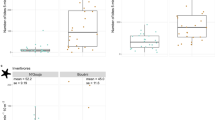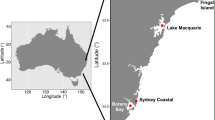Abstract
Two methods were used to assess the grazing impact of roving herbivorous fishes across a coral reef depth gradient within Pioneer Bay, Orpheus Island, Great Barrier Reef. The first technique employed was a method traditionally used to quantify herbivory on coral reefs via the (indirect) inference of herbivore impact from biomass estimates and reported feeding rates. The second method (one of a range of direct approaches) used remote underwater video cameras to film the daily feeding activity of roving herbivores in the absence of divers. Both techniques recorded similar patterns and relative levels of herbivore biomass across five reef zones at the study site. Indirect estimates of the grazing impact across the reef depth gradient of the three predominant species of herbivore broadly coincided with levels quantified directly by remote underwater video, indicating that, to a large extent, presence does correspond to function. However, the video data suggested that, for individual species in particular reef zones, the absolute level of impact may be less than that inferred from presence. In the case of the parrotfish Scarus rivulatus, the video recordings suggested that, at the reef crest, an average of 52% (±18 SE) of each m2 area of reef would be grazed each month, compared with an area of 109% (±41 SE) suggested by inferring grazing activity from presence alone. Potential biases associated with remote video recorders may explain some of the discrepancy between values. Overall, the results suggest that, for some fish groups, the indirect method of inferring function from presence can provide a good indication of relative levels of herbivore impact across a coral reef.



Similar content being viewed by others
References
Bell JS, Craik GJS, Pollard DA, Russell BC (1985) Estimating length frequency distributions of large reef fish underwater. Coral Reefs 4:41–44
Bellwood DR (1995a) Direct estimate of bioerosion by two parrotfish species, Chlorurus gibbus and C. sordidus on the Great Barrier Reef, Australia. Mar Biol 121:419–429
Bellwood DR (1995b) Carbonate transport and within-reef patterns of bioerosion and sediment release by parrotfishes (family Scaridae) on the Great Barrier Reef. Mar Ecol Prog Ser 117:127–136
Bellwood DR, Wainwright PC (2001) Locomotion in labrid fishes: implications for habitat use and cross-shelf biogeography on the Great Barrier Reef. Coral Reefs 20:139–150
Bellwood DR, Hughes TP, Folke C, Nystrom M. (2004) Confronting the coral reef crisis. Nature 429:827–833
Bellwood DR, Hughes TP, Hoey AS (2006) Sleeping functional group drives coral reef recovery. Curr Biol 16:2434–2439 doi:10.1016/j.cub.2006.10.030
Brock RE (1982) A critique of the visual census method for assessing coral reef fish populations. Bull Mar Sci 32:269–276
Bruggemann JH, van Oppen MJH, Breeman AM (1994) Foraging by the stoplight parrotfish Sparisoma viride I. Food selection in different, socially determined habitats. Mar Ecol Prog Ser 106:41–55
Bruggemann JH, van Kessel AM, van Rooij JM, Breeman AM (1996) Bioerosion and sediment ingestion by the Caribbean parrotfish Scarus vetula and Sparisoma viride: implications of fish size, feeding mode and habitat use. Mar Ecol Prog Ser 134:59–71
Cappo M, Speare P, De’ath G (2004) Comparison of baited remote underwater video stations (BRUVS) and prawn trawls for assessments of fish biodiversity in inter-reefal areas of the Great Barrier Reef Marine Park. J Exp Mar Biol Ecol 302:123–152
Chapman CJ, Johnston ADF, Dunn JR, Creasey DJ (1974) Reactions of fish to sound generated by diver’s open-circuit underwater breathing apparatus. Mar Biol 27:357–366
Choat JH, Clements KD, Robbins WD (2002) The trophic status of herbivorous fishes on coral reefs I: dietary analyses. Mar Biol 140:613–623
Davis GE, Anderson TW (1989) Population estimates of four kelp forest fishes and an evaluation of three in situ assessment techniques. Bull Mar Sci 44:1138–1151
Edgar GJ, Barrett NS, Morton AJ (2004) Biases associated with the use of underwater visual census techniques to quantify the density and size-structure of fish populations. J Exp Mar Biol Ecol 308:269–290
Fox RJ, Bellwood DR (2007) Quantifying herbivory across a coral reef depth gradient. Mar Ecol Prog Ser 339:49–59
Green LE, Alevison WS (1989) Comparative accuracies of visual assessment methods for coral reef fishes. Bull Mar Sci 44:899–912
Harvey E, Fletcher D, Shortis M (2001a) A comparison of the precision and accuracy of estimates of reef-fish lengths determined visually by divers with estimates produced by a stereo-video system. Fish Bull 99:63–71
Harvey E, Fletcher D, Shortis M (2001b) Improving the statistical power of length estimates of reef fish: a comparison of estimates determined visually by divers with estimates produced by a stereo-video system. Fish Bull 99:72–80
Harvey E, Fletcher D, Shortis MR, Kendrick GA (2004) A comparison of underwater visual distance estimates made by SCUBA divers and a stereo-video system: implications for underwater visual census of reef fish abundance. Mar Freshw Res 55:573–580
Hatcher BG, Larkum AWD (1983) An experimental analysis of factors controlling the standing crop of the epilithic algal community on a coral reef. J Exp Mar Biol Ecol 69:61–84
Hay ME (1981) Herbivory, algal distribution and the maintenance of between habitat diversity on a tropical fringing reef. Am Nat 118:520–540
Hoey AS, Bellwood DR (2007) Cross-shelf variation in the role of parrotfishes on the Great Barrier Reef. Coral reefs doi: 10.10007/s00338-007-0287x
Hixon MA, Brostoff WN (1996) Succession and herbivory: effects of differential fish grazing on Hawaiian coral-reef algae. Ecol Monogr 66:67–90
Hughes TP (1994) Catastrophes, phase shifts, and large scale degradation of a Caribbean coral reef. Science 265:1547–1551
Hughes TP, Bellwood DR, Folke C, Steneck RS, Wilson J (2005) New paradigms for supporting the resilience of marine ecosystems. Trends Ecol Evol 20:380–386
Hughes TP et al. (2007) Phase shifts, herbivory and the resilience of coral reefs to climate change. Curr Biol 17:1–6 doi:10.1016/j.cub.2006.12.049
Klumpp DW, McKinnon AD (1989) Temporal and spatial patterns in primary production of a coral reef epilithic algal community. J Exp Mar Biol Ecol 131:1–22
Klumpp DW, Polunin NVC (1989) Partitioning among grazers of food resources within damelfish territories on a coral reef. J Exp Mar Biol Ecol 125:145–169
Kulbicki M (1998) How the acquired behaviour of commercial reef fishes may influence the results obtained from visual censuses. J Exp Mar Biol Ecol 222:11–30
Kulbicki M, Guillemot N, Amand M (2005) A general approach to length–weight relationships for New Caledonian lagoon fishes. Cybium 29:235–252
Lincoln-Smith MP (1988) Effects of observer swimming speed on sample counts of temperate rocky reef fish assemblages. Mar Ecol Prog Ser 43:223–231
McClanahan TR, Sala E, Stickles PA, Cokos BA, Baker AC, Starger CJ, Jones SH (2003) Interaction between nutrients and herbivory in controlling algal communities and coral condition on Glover’s Reef, Belize. Mar Ecol Prog Ser 261:135–147
Mumby PJ et al. (2006) Fishing, trophic cascades, and the process of grazing on coral reefs. Science 311:98–101
Polunin NVC, Klumpp DW (1992) Algal food supply and grazer demand in a very productive coral-reef zone. J Exp Mar Biol Ecol 164:1–15
Russ GR (2003) Grazer biomass correlates more strongly with production than with biomass of algal turfs on a coral reef. Coral Reefs 22:63–67
Sale PF, Sharp BJ (1983) Correction for bias in visual transect censuses of coral reef fishes. Coral Reefs 2:32–42
Schmitt EF, Sluka RD, Sullivan-Sealey KM (2002) Evaluating the use of roving diver and transect surveys to assess the coral reef fish assemblage of Southeastern Hispaniola. Coral Reefs 21:216–223
Scott FJ, Russ GR (1987) Effects of grazing on species composition of the epilithic algal community on coral reefs of the central Great Barrier Reef. Mar Ecol Prog Ser 39:293–304
Thompson AA, Mapstone BD (1997) Observer effects and training in underwater visual surveys of reef fishes. Mar Ecol Prog Ser 154:53–63
Thresher RE, Gunn JS (1986) Comparative analysis of visual census techniques for highly mobile, reef associated piscivores (Carangidae). Environ Biol Fish 17:93–116
Tessier E, Chabanet P, Othin K, Soria M, Lasserre G (2005) Visual census of tropical fish aggregations on artificial reefs: slate versus video recording techniques. J Exp Mar Biol Ecol 315:17–30
Travis J (1982) A method for the statistical analysis of time-energy budgets. Ecology 63:19–25
Watson DL, Harvey ES, Anderson MJ, Kendrick GA (2005) A comparison of temperate reef fish assemblages recorded by three underwater stereo–video techniques. Mar Biol 148:415–425 doi:10.1007/s00227-005-0090-6
Williams ID, Polunin NVC (2001) Large scale associations between macroalgal cover and grazer biomass on mid-depth reefs in the Caribbean. Coral Reefs 19:358–366
Willis TJ, Babcock RC (2000) A baited underwater video system for the detection of relative density of carnivorous reef fish. Mar Freshw Res 51:755–763
Willis TJ, Millar RB, Babcock RC (2000) Detection of spatial variability in relative density of fishes: comparison of visual census, angling, and baited underwater video. Mar Ecol Prog Ser 198:249–260
Acknowledgments
We thank the staff of Orpheus Island Research Station for provision of support and facilities; A. Hoey, C. Mantyka, C. Ryen and T. Sunderland for field assistance; A. Hoey, C. Fulton and two anonymous reviewers for helpful comments on the manuscript and S. Wismer for help with manuscript preparation. This work was supported by the Australian Research Council (DRB). These experiments comply with current Australian legislation.
Author information
Authors and Affiliations
Corresponding author
Additional information
Communicated by S.D. Connell.
Electronic supplementary material
Rights and permissions
About this article
Cite this article
Fox, R.J., Bellwood, D.R. Direct versus indirect methods of quantifying herbivore grazing impact on a coral reef. Mar Biol 154, 325–334 (2008). https://doi.org/10.1007/s00227-008-0927-x
Received:
Accepted:
Published:
Issue Date:
DOI: https://doi.org/10.1007/s00227-008-0927-x




